Diuris maculata, commonly known as the spotted doubletail, is a species of orchid endemic to New South Wales. It has up to two or three folded leaves and a flowering stem with up to eight yellow flowers with brown to blackish markings. It is similar to D. pardina which has darker flowers with larger brown markings.

Diuris sulphurea, commonly called the tiger orchid or hornet orchid, is a species of orchid which is endemic to eastern Australia. It has up to three leaves, and a flowering stem with up to seven bright yellow flowers with dark brown markings.

Diuris protena, commonly known as northern golden moths, is a species of orchid which is endemic to Victoria. It has a tuft of between four and eight leaves at the base and up to three mostly yellow flowers with a few light-coloured marks. It is classed as "endangered" in Victoria.
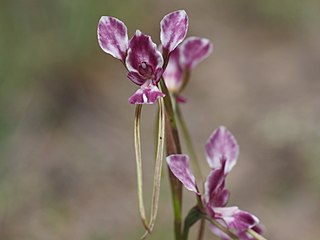
Diuris dendrobioides, commonly known as the wedge diuris, is a species of orchid which is endemic to eastern Australia. It has one or two leaves and a flowering stem with up to six pale lilac-coloured to mauve flowers with darker markings.

Diuris brevifolia, commonly known as the short-leaved donkey orchid, is a species of orchid which is endemic to South Australia. It has a few narrow, twisted leaves and a flowering stem with up to five bright yellow flowers with brown markings and relatively large, spreading lobes on the labellum. This is a relatively late-flowering species of donkey orchid.
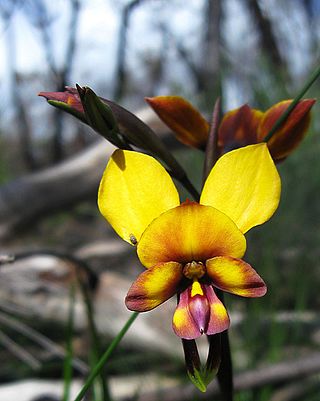
Diuris magnifica, commonly called the large pansy orchid is a species of orchid which is endemic to the south-west of Western Australia. It has large, colourful flowers and is common in a narrow range near the coast around Perth, often occurring with the similar but smaller Diuris corymbosa.
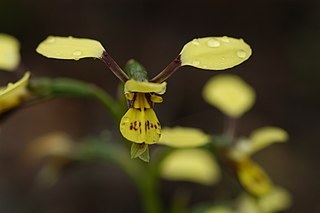
Diuris praecox, commonly known as the early doubletail, Newcastle doubletail or rough doubletail is a species of orchid which is endemic to New South Wales. It has two or three grass-like leaves and up to ten light yellow flowers with a few dark brown marks. It is threatened by urbanisation.
Diuris exitela, commonly called the Mount Moffat doubletail, is a species of orchid which is endemic to central western Queensland. It has two linear leaves at its base, up to twelve bright yellow flowers with dark brown markings and grows on sandstone cliffs and ridges.
Diuris fucosa is a species of orchid that is endemic to New South Wales. It between four and seven leaves and up to four pale yellow flowers with a few brown striations. It is only known from two sites in Callitris woodland in the south of the state and is classed as "extinct" in Victoria.

Diuris gregaria, commonly known as clumping golden moths is a species of orchid that is endemic to Victoria. It between three and seven leaves and one or two bright yellow flowers with a few dark striations and usually grows in dense tufts of up to thirty plants. It is a rare species mostly only found in grassland west of Melbourne.
Diuris heberlei, commonly called Heberle's donkey orchid, is a species of orchid which is endemic to the south-west of Western Australia. It has three to five linear leaves at its base and up to four bright yellow flowers with a reddish brown border around the labellum callus. It is found along the south coast and is one of the last Diuris to flower in Western Australia.
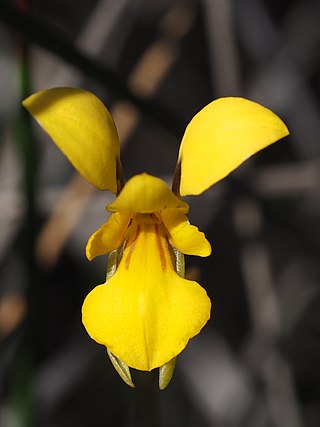
Diuris laevis, commonly known as the nanny goat orchid, is a rare species of orchid that is endemic to the south-west of Western Australia. It has between four and eight leaves and up to six pale yellow flowers which usually have reddish-brown markings. It has an unusually short dorsal sepal and wide labellum and is relatively common between Bunbury and Albany.
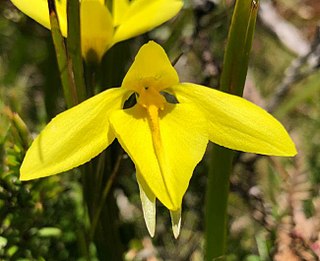
Diuris lanceolata, commonly known as large golden moths, is a species of orchid that is endemic to Tasmania. It has between two and four leaves and up to three golden to orange-yellow flowers with a few dark streaks.
Diuris micrantha, commonly called the dwarf bee orchid or tiny bee orchid, is a rare species of orchid which is endemic to the south-west of Western Australia. It has four to six linear leaves at its base and up to six yellow flowers with reddish brown markings. It grows in swampy places south of Perth.

Diuris monticola, commonly known as highland golden moths, is a species of orchid that is endemic to south-eastern Australia. It is a common and widespread, late flowering species growing in grassland and woodland habitats at higher altitudes. It has a tuft of up to nine leaves at the base and up to four slightly drooping bright yellow flowers with dark streaks in the centre.

Diuris platichila, commonly known as the Blue Mountains doubletail, is a species of orchid that is endemic to a few isolated places in the Blue Mountains in New South Wales. It has two leaves and up to eight yellow flowers with dark markings on the dorsal sepal and labellum. It has relatively long, thin lateral sepals and the central lobe of the labellum is wedge-shaped. It forms hybrids with other species of Diuris.

Diuris pulchella, commonly called the beautiful donkey orchid is a species of orchid that is endemic to the south-eastern part of the south-west of Western Australia. It has two or three leaves at its base and up to five bright yellow and mauve flowers described as "exquisite", "spectacular" and "attractive". It grows in shallow soil on granite outcrops near Esperance.
Diuris secundiflora, commonly known as the one-sided donkey orchid, is a poorly-known species of orchid that is endemic to New South Wales. It has a single grass-like leaf and up to eight yellow flowers that are sometimes spotted and are all arranged on one side of the flowering stem.
Diuris striata is a poorly-known species of orchid that is endemic to New South Wales. It has a two grass-like leaves and about four mauve flowers with dark purple streaks on the labellum.
Diuris unica is a species of orchid which is endemic to eastern Australia. It usually has only one grass-like leaf at its base and up to eight bright, lemon-yellow flowers with a few dark markings. It is similar to D. chrysantha but flowers much earlier than that species and has only a single leaf rather than two.











